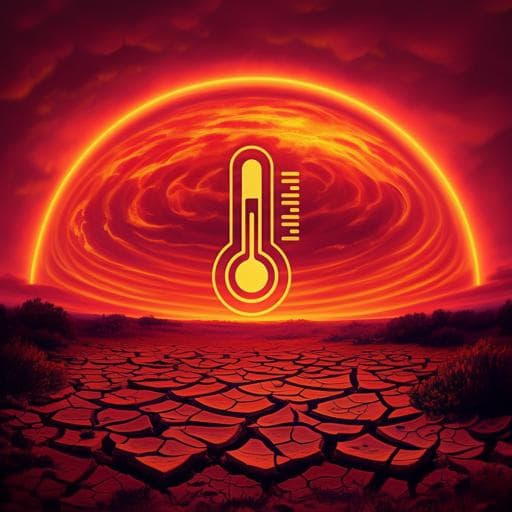
Earth Sciences
Increased impact of heat domes on 2021-like heat extremes in North America under global warming
X. Zhang, T. Zhou, et al.
Explore the striking findings of a groundbreaking study by Xing Zhang and colleagues, which reveals how the 2021 heatwave in Western North America was significantly intensified by a heat dome system. This research uncovers that limiting global warming can greatly reduce the exposure of populations to extreme heat events.
~3 min • Beginner • English
Introduction
Climate extremes, including heatwaves, heavy rainfall and drought, have intensified since the 1950s, with the most significant changes in hot extremes. Numerous record-breaking heatwaves have been documented globally. During late June 2021, Western North America (WNA) experienced an extraordinary heatwave with daily maximum temperature anomalies reaching 16–20 °C in many cities, causing over 1400 deaths and widespread wildfires. Heat events are closely linked to atmospheric circulation anomalies, typically anomalous high-pressure systems that enhance insolation, advect warm air, and reinforce subsidence. The flow analog method enables quantification of the circulation contribution to extremes. While previous studies highlight circulation persistence in major heat events, there is a lack of quantitative estimation of the atmospheric circulation’s contribution to the unprecedented 2021 WNA heatwave and how the heat dome has and will continue to affect such events. This study uses the flow analog method to quantify the heat dome’s contribution to the 2021 event and to examine how background warming influences the intensity and probability of such heatwaves, including the role of soil moisture-atmosphere feedbacks and implications for future frequency and population exposure.
Literature Review
Prior work has shown increased intensity and frequency of hot extremes globally and has analyzed notable heatwaves across Australia (2012–2013), East Asia (2013, 2018), and Europe (2017). Heatwaves are strongly associated with persistent anticyclonic anomalies. The flow analog method has been used to quantify circulation contributions to European and East Asian extremes, often finding that circulation explains a substantial fraction of temperature anomalies. Rapid attribution for the 2021 WNA heatwave indicated a large increase in probability due to anthropogenic climate change. However, quantitative estimates of the circulation’s contribution to the 2021 event over WNA and its future influence remained limited. Additionally, literature emphasizes soil moisture–temperature feedbacks as key amplifiers of hot extremes, with studies documenting their role in regional amplification of temperature extremes and interactions with circulation, cloud cover, and radiation.
Methodology
The study combines observations/reanalysis with large-ensemble climate simulations. Observations include daily maximum temperature (tmax) during 2021 from GHCN-D and daily ERA5 fields (z500, z300, z700, z850 geopotential heights and soil moisture) for 1959–2021, with anomalies relative to 1981–2010. CESM1 Large Ensemble (40 members) provides daily tmax and z500 for historical (to 2005, extended with RCP8.5 to 2021) and future RCP8.5 (2021–2100) simulations, plus a preindustrial control and last millennium ensemble (850–2005). Data are regridded to 1°×1°. Population projections under SSP3 and SSP5 (2010–2100) are aggregated to 1°×1° for exposure analysis.
Extreme index: TXx7 is defined as the JJA annual maximum of the 7-day running mean of area-weighted tmax anomaly over WNA (40°–65°N, 105°–125°W), i.e., the hottest week per year. Bias correction aligns simulated TXx7 with observations using a trend-preserving constant offset estimated over 1981–2005.
Flow analog method: To quantify circulation contributions, eddy z500 anomalies (zonal-mean removed) over WNA are used as the proxy. For each event day (27 June–3 July 2021), the 20 best analog days within ±30 days of the calendar window from other years are selected based on Euclidean distance (pattern correlation gives similar results). A conditional distribution of tmax anomalies is obtained by randomly sampling one of the 20 analogs per day, averaging over the event, and repeating 1000 times. A control distribution is built from randomly sampled days of equal length without circulation conditioning. Temperatures are detrended to remove background warming. The approach is similarly applied to CESM1 historical, preindustrial control (split into 54 30-year segments for fair analog selection), and to future warming levels determined by 11-year running global mean temperature (1, 2, 3, 4 °C above 1850–1920).
Soil moisture analysis: Lead–lag correlations between tmax and soil moisture anomalies are computed for May–August 2021. Soil moisture distributions conditional on the heat dome circulation (simultaneous and preceding month) are compared to randomly sampled days. A soil-moisture analog method selects days with similar soil moisture anomaly fields over WNA to quantify the soil moisture contribution to tmax anomalies.
Attribution metrics: Probability ratio (PR = Phistorical/PpiControl) and fraction of attributable risk (FAR = 1 − PpiControl/Phistorical) are estimated with bootstrapping.
Future risk and exposure: Using the 2021 TXx7 (7.61 °C) as threshold, the frequency of exceedance (7-day running mean in JJA) is computed per grid and averaged over WNA. Population exposure equals frequency times grid population, calculated per decade. Warming-level analyses use the 11-year windows around the model’s timing of 1.5 °C (2029), 2.0 °C (2041), and 3.0 °C (2060) above preindustrial; exposure uses the 2030s, 2040s, and 2060s populations, respectively. Avoided impacts between warming levels are quantified as percentage reductions relative to higher-warming cases.
Key Findings
- The 2021 WNA hottest week (27 June–3 July) had a region-averaged tmax anomaly of 10.13 °C relative to 1981–2010, and the TXx7 index in 2021 exceeded 5σ, breaking records since 1959; model last-millennium simulations indicate unprecedented conditions.
- Flow analogs show the heat dome circulation explains 54.64% of the observed temperature anomaly: median analog tmax anomaly 3.67 °C (IQR 3.36–3.97 °C) versus observed 6.71 °C (detrended). Sensitivities show similar contributions (~50%) across domain sizes and event durations, with the largest for 7 days; using eddy z300 yields a higher contribution (68.06%).
- Time series reveal accelerated warming of TXx7 since the 1990s without a corresponding trend in heat dome–like circulation anomalies. PDFs show strong rightward shift of TXx7 from preindustrial to historical (PR≈807, FAR≈1), while circulation PDFs are statistically indistinguishable between preindustrial and historical (K–S p=0.64).
- Future projections (RCP8.5): TXx7 extremes intensify, with ~33% probability of 2021-like events by mid-century (2041–2060), and such events becoming average by 2081–2100. The probability of extreme heat-dome-like circulation (>2021 anomaly) increases modestly to 4.2%, 5.1%, 6.1% in near-, mid-, long-term (≈1.8×, 2.2×, 2.6× historical), smaller than temperature increases but still significant.
- Intensities of hot extremes under similar circulations increase faster than global mean temperature. ERA5 shows higher detrended tmax anomalies in 1991–2020 than 1959–1990 under similar heat domes. CESM1 indicates tmax anomalies under similar heat domes rise from preindustrial (2.94 °C; 2.53–3.35 °C) to earlier (3.23 °C; 2.83–3.63 °C) and present periods (3.26 °C; 2.87–3.66 °C). For a global mean warming increase from 1 °C to 3 °C, tmax under similar circulations increases by about 3.5 °C.
- Soil moisture–temperature feedback is strong: largest simultaneous negative correlation in 2021; the heat dome co-occurs with soil moisture deficits, while preceding-month soil moisture does not drive the dome formation. Soil moisture analogs attribute 50.6% of the high temperature to soil moisture feedback. Recent decades show drier soil moisture under similar domes and enhanced feedback, partly explaining faster-than-mean increases of hot extremes.
- Frequency and exposure: By 2100 under RCP8.5, the frequency of 2021-like heat events increases by ~40-fold relative to 2021. At 1.5 °C, 2.0 °C, and 3.0 °C global warming, frequencies are about 2×, 3×, and 10× the 2021 frequency; limiting warming to 1.5 °C avoids ~65% (vs 2 °C) and 92% (vs 3 °C) of frequency increase. Population exposure rises markedly: under RCP8.5–SSP3, to 0.09, 0.16, and 0.44 billion person-events at 1.5 °C, 2 °C, and 3 °C, respectively; under RCP8.5–SSP5, exposure increases by about 3-, 7-, and 26-fold relative to the baseline. Limiting warming to 1.5 °C avoids 53% (vs 2 °C) and 89% (vs 3 °C) of the increase in exposure under RCP8.5–SSP5.
- For unprecedented modeled extremes (TXx7 >6σ, >8σ, >12σ) under RCP8.5, circulation contributions remain substantial but slightly decrease with event magnitude: 53.86%, 50.24%, and 44.77%, respectively.
Discussion
The analysis demonstrates that the 2021 WNA heatwave’s exceptional temperatures were driven by both an intense heat dome and thermodynamic amplification from a warmer background climate. Even without a systematic strengthening of heat-dome-like circulation, background warming and enhanced soil moisture–atmosphere feedback substantially raise the temperatures attained under similar circulations. This explains why hot extremes intensify faster than mean warming under comparable atmospheric patterns. Models and observations consistently show large anthropogenic influence on the probability of 2021-like extremes (PR≈807, FAR≈1) and project rapidly increasing frequency and population exposure under continued high emissions. The modest but significant rise in heat-dome-like circulation probability further augments the risk. These results reinforce the central role of thermodynamic warming and land–atmosphere coupling in shaping extreme heat risk, highlighting the importance of stringent warming limits for reducing impacts in Western North America.
Conclusion
This study quantifies the heat dome’s contribution to the 2021 WNA heatwave, attributing over half of the temperature anomaly to circulation and a comparable fraction to soil moisture–temperature feedback. It shows that under similar atmospheric patterns, hot extremes intensify faster than global mean temperature due to background warming and strengthened land–atmosphere coupling. Projections indicate a dramatic increase in the frequency of 2021-like events and population exposure under RCP8.5, while limiting warming to 1.5 °C substantially reduces both frequency and exposure. Future work should examine dynamical causes of the limited trend in heat-dome-like circulation, better constrain soil moisture–cloud–radiation interactions, assess model dependence related to climate sensitivity, and integrate multiple attribution methods to reduce sampling uncertainties.
Limitations
- Flow analog results depend on choices of domain size, circulation proxy level, and event duration; sensitivity tests show qualitative robustness but quantitative differences remain.
- Observational sampling limits can hinder finding truly similar analogs, introducing sampling uncertainty.
- Feedbacks (e.g., soil moisture, snow/ice albedo, clouds) are not fully accounted for when selecting circulation analogs; interactions among atmosphere, clouds, and soil moisture are complex and intertwined.
- Persistence of circulation may reduce effective sample sizes because analogs across days can be correlated.
- Model dependence: CESM1 has relatively high equilibrium climate sensitivity (~4.1 °C), potentially affecting long-term warming and extremes; although using warming levels mitigates sensitivity effects, residual uncertainty remains.
Related Publications
Explore these studies to deepen your understanding of the subject.







